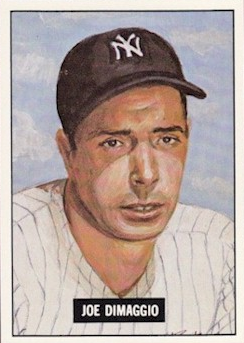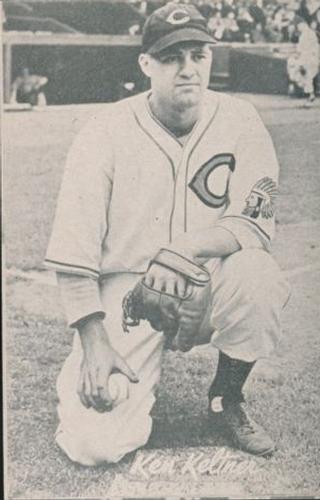July 17, 1941: DiMaggio’s streak stopped at 56 by Cleveland’s stellar defense
 On June 1, 1941, Joe DiMaggio hit a ball sharply toward third base. The ball hit the edge of the glove of Cleveland Indians third baseman Ken Keltner and bounced away. It was scored as a single, but Keltner reprimanded himself for not making the play. He made a mental note: He had to play DiMaggio farther back.1
On June 1, 1941, Joe DiMaggio hit a ball sharply toward third base. The ball hit the edge of the glove of Cleveland Indians third baseman Ken Keltner and bounced away. It was scored as a single, but Keltner reprimanded himself for not making the play. He made a mental note: He had to play DiMaggio farther back.1
That single quietly extended DiMaggio’s hitting streak to 18 games. When the Yankees returned to Cleveland in mid-July, having overtaken the Indians for first place in the American League, the streak was front-page news nationwide. Fans welcomed the diversion from the drumbeat of war that was dominating the rest of the news.
DiMaggio arrived in Cleveland claiming the pressure of the streak had subsided. After all, he had cruised past George Sisler’s modern major-league record hitting streak of 41 games, passed Willie Keeler’s nineteenth-century mark of 44, cleared 50 in St. Louis and reached 55 in Chicago. Other than matching his minor-league streak of 61, at this point everything else was gravy. “The pressure’s completely off now,” DiMaggio told the press. “I go to bat just as relaxed as if there had never been any streak.”2 The Cleveland Plain Dealer agreed: “The pressure is definitely off, so don’t be surprised if Joe DiMaggio extends his phenomenal consecutive hitting streak into the month of August.”3
In reality, though, the pressure was building with every game, the tension mounting with every at-bat that left DiMaggio hitless. “You can’t imagine the strain,” Sisler said that summer. “You try to forget, but it can’t be done. It’s in your head every time you step to the plate.”4 “When Joltin’ Joe came to bat, the entire Yankees bench stood at the edge of the dugout and exhorted him to get a hit,” Cleveland fan Joseph Oriti recalled. “Every at-bat had a heightened dimension.”5
The Yankees pounded the Indians 10-3 in the series opener on July 16, opening up a six-game lead in the standings. DiMaggio singled in the first inning to snap the suspense, and added a single and a double to finish 3-for-4. His hitting streak stood at 56 games.
That game was played at cramped League Park, in front of 15,000 fans. The July 17 game would be held under the lights at massive Cleveland Stadium. With history on the line, 67,468 fans poured into the stadium – the largest crowd in baseball that summer, and a new record for a night game.6
The crowd didn’t have to wait long to see DiMaggio. An RBI double by Tommy Henrich in the top of the first inning off Indians left-hander Al Smith gave the Yankees a 1-0 lead and brought DiMaggio to the plate. Ken Keltner, mindful of DiMaggio’s hit that handcuffed him on June 1 right here at Cleveland Stadium, was playing well back, heels on the outfield grass, and close to the line.7
 Keltner, who was becoming a perennial All-Star more for his glove than for his bat, later said he was thinking about the pennant race, not the streak.8 He knew DiMaggio rarely bunted (DiMaggio had zero bunts in the last 56 games), he said, and that DiMaggio pulled curveballs off lefties.9 Author Michael Seidel asked DiMaggio decades later how deep Keltner was playing him that day. “Deep?” DiMaggio replied. “My God, he was standing in left field.”10
Keltner, who was becoming a perennial All-Star more for his glove than for his bat, later said he was thinking about the pennant race, not the streak.8 He knew DiMaggio rarely bunted (DiMaggio had zero bunts in the last 56 games), he said, and that DiMaggio pulled curveballs off lefties.9 Author Michael Seidel asked DiMaggio decades later how deep Keltner was playing him that day. “Deep?” DiMaggio replied. “My God, he was standing in left field.”10
DiMaggio swung at a curveball over the plate and lined it hard down the third-base line.11Keltner lunged toward it and made a backhand stab behind the bag. His momentum took him into foul territory, but he planted and fired to first. DiMaggio, slowed out of the box by damp dirt after rain earlier that day, was out by half a step.12
DiMaggio’s next at-bat came in the top of the fourth with the score still 1-0. After working the count full, DiMaggio decided to swing at anything in the vicinity of the plate.13 The next pitch was a changeup and he fouled it off. Then Smith sent a curveball so far inside that DiMaggio couldn’t turn the bat around; he took it for ball four.14 The crowd booed Smith for the walk,15 reflecting mixed feelings they would display the whole night. They wanted the Indians to win, but they were also pulling for DiMaggio. “If ever 67,468 people were confused,” wrote Seidel, “this was the night.”16
The crowd had no ambivalence in the bottom half of the fourth, when Gee Walker hit an inside-the-park home run to tie the game. The game was still tied in the seventh when DiMaggio came up with one out and no one on. At third, Keltner was standing even farther back this time, and even closer to the line.17Keltner had barely gotten DiMaggio out on his hard shot down the line in the first, and wanted to be ready for another one.
That’s exactly what he got. DiMaggio swung at the first pitch, another curveball on the inside corner, and hit a carbon copy of his first-inning line drive. Keltner was better positioned this time but still had to make a quick play. Once again, Keltner backhanded it behind the base, threw across his body, and barely beat DiMaggio. Keltner had robbed DiMaggio of two doubles.18 The nervous crowd started to weigh the consequences.
The Yankees took the lead on a home run by the next batter, Joe Gordon, and scored two more in the eighth for a 4-1 lead. Then Smith walked Henrich to load the bases with one out, and the Indians brought in reliever Jim Bagby Jr. DiMaggio was up next. Fans leaned forward, knowing this was his last chance. “You could hear everybody’s heart pounding, on both sides,” recalled Indians shortstop Lou Boudreau.19
Bagby delivered a low fastball and DiMaggio caught the top of it, bouncing it toward Boudreau. After a couple of hops the ball struck a stone in the grass and shot straight up in the air. But in an instant, Boudreau made the adjustment, grabbed the ball at shoulder height, tossed it to Ray Mack at second to retire Henrich, and watched Mack fire to first in time for the double play to end the inning. DiMaggio was 0-for-3 with a walk. Without betraying any emotion, DiMaggio retrieved his glove and trotted out to center field.20
In the ninth inning the Indians gave the crowd a glimmer of hope both for a win and another DiMaggio at-bat. The Yankees sent five men to the plate without scoring, turning over the lineup for a possible 10th inning. Then the Indians started the bottom of the ninth with two singles off Lefty Gomez and a pinch-hit triple by Larry Rosenthal off reliever Johnny Murphy. It was 4-3, and the tying run was on third with nobody out.
But hopes of extra innings vanished just as quickly as they arose, with a grounder to first, a grounder to the pitcher that caught Rosenthal in a rundown, and another grounder to first for the third out.21 The game was over, and so was DiMaggio’s hitting streak.
The Yankees clubhouse was about as quiet as it had ever been after a win, let alone one that gave them command of the pennant race. “The whole thing was bound to stop sooner or later,” DiMaggio told the press.22 He agreed to pose for photographers with his thumb and forefinger forming a zero, indicating his hit total that night. “I’m not happy that I failed to get a hit,” he said. “I guess relieved would be the better word.23
Keltner exited promptly, receiving police protection out of the stadium.24 DiMaggio waited for hours for the stadium to clear out. His only complaint to rookie teammate Phil Rizzuto was that he had missed out on a promotional bonus of $10,000 from Heinz 57 if he had reached their magic number.25
After two months, 56 games, 91 hits, 15 home runs, and only five strikeouts, DiMaggio’s hitting streak was over. He had been stopped by breathtaking defensive plays and a ninth-inning rally that fell just short. “The game was among the most memorable ever played,” Seidel wrote.26 “Despite being a tried and true Indians fan all my life, I was disappointed,” recalled Joseph Oriti. “It still resonates far beyond any game I ever saw. Any fan in attendance would attest that they witnessed a game unparalleled in the realm of baseball.27
DiMaggio immediately started a new streak, hitting safely in his next 16 games. Granted, pitchers were less cautious with him and DiMaggio was more relaxed at the plate. But it doesn’t strain the imagination to think that but for Cleveland’s stout infield on July 17, DiMaggio’s immortal number could have been 73. Or at least 57.
Sources
In addition to the sources mentioned in the Notes, the author consulted Baseball-reference.com and Retrosheet.org.
http://www.baseball-reference.com/boxes/CLE/CLE194107170.shtml
http://www.retrosheet.org/boxesetc/1941/B07170CLE1941.htm
Notes
1 Mike Vaccaro, 1941: The Greatest Year in Sports (New York: Knopf Doubleday, 2008), 192.
2 Vaccaro, 191.
3 Eugene J. Whitney, “Pressure Is Off, So Watch Joe Go,” Cleveland Plain Dealer, July 17, 1941: 15.
4 Gregg Klayman, “DiMaggio’s ‘Unbreakable’ Record,” MLB.com, July 24, 2002, archived at web.archive.org/web/20020813192435/http://mlb.mlb.com/NASApp/mlb/mlb/news/mlb_news.jsp?content_id=88502&fext=.jsp&vkey=news_mlb&ymd=20020724.
5 Joseph Oriti, “Night That Joe DiMaggio’s Hitting Streak Ended Was Magic: Cleveland Indians Memories,” Cleveland Plain Dealer, July 8, 2011, cleveland.com/tribe/index.ssf/2011/07/night_that_joe_dimaggios_hitti.html.
6 Kostya Kennedy, 56: Joe DiMaggio and the Last Magic Number in Sports (New York: Time Home Entertainment, 2011), 302.
7 Kennedy, 303.
8 Michael Seidel, Streak: Joe DiMaggio and the Summer of ’41 (Lincoln, Nebraska: U. of Nebraska Press, 2002), 202.
9 Ibid.
10 Ibid.
11 Kennedy, 304.
12 Seidel, 202.
13 Vaccaro, 193.
14 Ibid.
15 Kennedy, 304.
16 Seidel, Streak, 203.
17 Richard Ben Cramer, Joe DiMaggio: The Hero’s Life (New York: Simon and Schuster, 2001), 185.
18 Kennedy, 305.
19#Vaccaro, 194.
20 Kennedy, 307.
21 Ibid.
22 Vaccaro, 196.
23 Eugene J. Whitney, “Keltner ‘Rough On Me,’ Says DiMaggio as Ken Stops Batting Streak,” Cleveland Plain Dealer, July 18, 1941: 16.
24 Vaccaro, 196.
25 Cramer, 186.
26 Seidel, 201.
27 Oriti.
Additional Stats
New York Yankees 4
Cleveland Indians 3
Cleveland Stadium
Cleveland, OH
Box Score + PBP:
Corrections? Additions?
If you can help us improve this game story, contact us.

